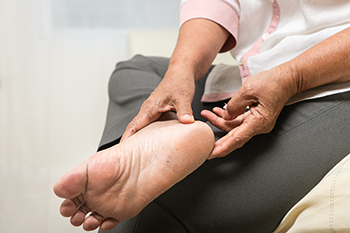
Charcot foot is a condition that affects the bones, joints, and soft tissues of the feet and ankles. It is caused mainly by nerve damage to the feet, usually as the result of peripheral neuropathy. Charcot foot is common to many diabetics because sustained high blood sugar levels cause both nerve and blood vessel damage in the feet. Because the feeling in the feet is lost, injuries to the bones in the feet are common. As the bones weaken, the joints can collapse, resulting in changes to the shape of the feet. The arch of the foot may collapse, causing the bottom of the foot to become rounded, which is known as rocker bottom foot. In addition, the toes may begin to curl under the feet and the ankle joints may become unstable. Charcot foot can be difficult to diagnose, as it can be masked by inflammation, swelling, and redness. But these symptoms may not be felt because of numbness. It is important to get treatment for Charcot foot early. If you believe you may have this condition, please consult a podiatrist as soon as possible.
Some foot conditions may require additional professional care. If you have any concerns, contact Howard Waxman, DPM of Pleasant Valley Podiatry. Our doctor can provide the care you need to keep you pain-free and on your feet.
Rare Foot Conditions
The majority of foot conditions are common and can be treated by a podiatrist. Standard diagnostic procedures are generally used to identify specific conditions and treatment can be rendered. A podiatrist also treats rare foot conditions which can be difficult to diagnose and may need extra attention and care.
There are many rare foot conditions that can affect children. Some of these can include:
Freiberg’s disease - This can be seen as a deterioration and flattening of a metatarsal bone that exists in the ball of the foot. It typically affects pre-teen and teenage girls, but can affect anyone at any age. Symptoms that can accompany this can be swelling, stiffness, and the patient may limp.
Kohler’s disease - This often targets the bone in the arch of the foot and affects younger boys. It can lead to an interruption of the blood supply which ultimately can lead to bone deterioration. The patient may limp or experience tenderness, swelling, and redness.
Maffucci syndrome - This affects the long bones in a child’s foot leading to the development of abnormal bone lesions. They are benign growths and typically develop in early childhood and the bones may be susceptible to breaking.
A podiatrist can properly diagnose and treat all types of rare foot conditions. If your child is affected by any of these symptoms or conditions, please don’t hesitate to call our office so the correct treatment method can begin.
If you have any questions please feel free to contact one of our offices located in Willoughby Hills and Broadview Heights, OH . We offer the newest diagnostic tools and technology to treat your foot and ankle needs.

It is odd, but factual, that women often wear the wrong shoe size and in most cases, their shoes are too short or narrow. When their feet are measured, they often react with denial that their feet have changed as they have “always worn the same size.” When checking shoe fit, one should allow at least half an inch between the big toe and the front part of the shoe. The pinky toe should not push against the side of the shoe. Women are more apt to prefer pointier toe boxes, instead of round ones. It might be OK if a woman’s feet are narrow, but if they are medium to extra wide, wearing such shoes can be painful and cause conditions like ingrown toenails, bunions, or hammertoes. The truth is that foot's shape and shoe size change over time. Some things that contribute to a change in shoe size are pregnancy, aging, and weight gain or loss. Over time, feet can get longer and wider because arches decrease, and the foot flattens and lengthens. If you are experiencing foot pain, it might be helped by simply having your feet measured and wearing a half-inch size larger shoe. Consult with a podiatrist who can properly measure your feet and discuss how you might better approach thinking about shoe size.
Getting the right shoe size is an important part of proper foot health. Seek the assistance of Howard Waxman, DPM from Pleasant Valley Podiatry. Our doctor will provide the care you need to keep you pain-free and on your feet.
Getting the Right Shoe Size
There are many people who wear shoes that are the incorrect size, negatively affecting their feet and posture. Selecting the right shoes is not a difficult process, so long as you keep several things in mind when it comes to choosing the right pair.
As our feet hold our body weight and keep us moving, it is important to treat them right. Picking the right pair of shoes can provide your feet comfort and mobility without pain.
If you have any questions, please feel free to contact one of our offices located in Willoughby Hills and Broadview Heights, OH . We offer the newest diagnostic and treatment technologies for all your foot care needs.

Athlete’s foot is a foot condition that can be uncomfortable and unsightly. It is caused by a fungus that lives in warm environments such as public swimming pools, shower room floors, and locker rooms. The symptoms that often accompany this can include itchiness between the toes and on the bottom of the foot, and the skin can be white and soggy. Some people have cracked skin with this ailment, in addition to small blisters. Patients who have a weakened immune system may be prone to getting athlete’s foot, in addition to having poor foot hygiene. Some people have learned to avoid athlete’s foot by wearing appropriate shoes while in public places, and refraining from sharing towels, shoes, and socks. It may help to use foot powder inside the shoes, which may aid in prevention. If you have this foot condition, it is strongly suggested that you are under the care of a podiatrist who can prescribe medication for complete healing.
Athlete’s Foot
Athlete’s foot is often an uncomfortable condition to experience. Thankfully, podiatrists specialize in treating athlete’s foot and offer the best treatment options. If you have any questions about athlete’s foot, consult with Howard Waxman, DPM from Pleasant Valley Podiatry. Our doctor will assess your condition and provide you with quality treatment.
What Is Athlete’s Foot?
Tinea pedis, more commonly known as athlete’s foot, is a non-serious and common fungal infection of the foot. Athlete’s foot is contagious and can be contracted by touching someone who has it or infected surfaces. The most common places contaminated by it are public showers, locker rooms, and swimming pools. Once contracted, it grows on feet that are left inside moist, dark, and warm shoes and socks.
Prevention
The most effective ways to prevent athlete’s foot include:
Symptoms
Athlete’s foot initially occurs as a rash between the toes. However, if left undiagnosed, it can spread to the sides and bottom of the feet, toenails, and if touched by hand, the hands themselves. Symptoms include:
Diagnosis and Treatment
Diagnosis is quick and easy. Skin samples will be taken and either viewed under a microscope or sent to a lab for testing. Sometimes, a podiatrist can diagnose it based on simply looking at it. Once confirmed, treatment options include oral and topical antifungal medications.
If you have any questions, please feel free to contact one of our offices located in Willoughby Hills and Broadview Heights, OH . We offer the newest diagnostic and treatment technologies for all your foot care needs.

Many individuals might be candidates for different kinds of surgical procedures for the feet. These procedures can treat a wide variety of foot afflictions and might be necessary for some patients to heal from their condition. After you undergo a foot surgery, your podiatrist might recommend a variety of things that you can do post-surgery to help facilitate the healing and recovery process. For example, they might recommend performing certain physical exercises after foot surgery. They may also recommend exercising underwater, which reduces the amount of weight one puts on their feet. They might also recommend exercising your abdominals, which can ultimately increase stability and make walking easier. However, it is important to note that each person is uniquely different and one ought to closely follow the advice given by their podiatrist.
Foot surgery is sometimes necessary to treat a foot ailment. To learn more, contact Howard Waxman, DPM of Pleasant Valley Podiatry. Our doctor will assist you with all of your foot and ankle needs.
When Is Surgery Necessary?
Foot and ankle surgery is generally reserved for cases in which less invasive, conservative procedures have failed to alleviate the problem. Some of the cases in which surgery may be necessary include:
What Types of Surgery Are There?
The type of surgery you receive will depend on the nature of the problem you have. Some of the possible surgeries include:
Benefits of Surgery
Although surgery is usually a last resort, it can provide more complete pain relief compared to non-surgical methods and may allow you to finally resume full activity.
Surgical techniques have also become increasingly sophisticated. Techniques like endoscopic surgery allow for smaller incisions and faster recovery times.
If you have any questions please feel free to contact one of our offices located in Willoughby Hills and Broadview Heights, OH . We offer the newest diagnostic and treatment technologies for all your foot and ankle needs.